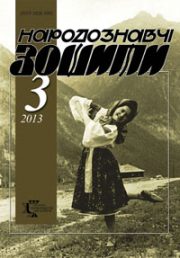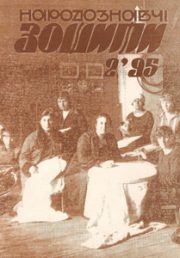The Ethnology Notebooks. 2018, 2 (140), 391—396.
UDK 745.9:398
DOI https://doi.org/10.15407/nz2018.02.391
Received 22.02.2018
CUSTOM FLORISTIC IN SLOVITA VILLAGE FROM LVIV REGION IN THE BEGINNING OF XXI CENTURY
Tsymbaliuk Olena, candidate of arts (Ph. D), docent
associate professor
at the Department of Graphic Design and Art of the Book,
Ukrainian Printing Academy.
19 Pid Goloskom str., Lviv, 79020, Ukraine
Abstrakt. Means of diversity forms Ukrainian national floristic, which in the resent time conserved in everyday life and dedicated to celebration of religious holidays, are consiered in the article.
Keywords: mistress, Ukrainian folk ritual, religious holiday, making, flowers, meaning, Slovita.
REFERENCES
Boriak, O. (2006). Ukraina: etnokul’turna mozaika. Kyiv: Lybid’ [in Ukrainian].
Katrij, Yu. (1982). Piznaj svij obriad! Liturhijnyj rik ukra¬ins’koi katolyts’koi tserkvy. (Ch. I.). N’iu-Jork; Rym: Vydavnytstvo OO. Vasylian [in Ukrainian].
Kylymnyk, S. (1957). Ukrains’kyj rik u narodnykh zvychaiakh v istorychnomu osvitlenni. (Vol. 4: Litnij tsykl). Vinnipeh; Toronto [in Ukrainian].
Koval’chuk, Ya. (1930). Sviata na Ukraini u zvychaiakh ta zabobonakh. Kharkiv; Kyiv: Derzhavne vydavnytstvo Ukrainy [in Ukrainian].
Stel’maschuk, H.H. (1993). Tradytsijni holovni ubory ukraintsiv. Kyiv: Naukova dumka [in Ukrainian].
Feduschak, M.L. (2008). Ukrains’ki narodni florystychni kompozytsii (kvitchannia): istoriia, funktsii, typolohiia, khudozhni osoblyvosti: avtoref. dys. kand. mystetstvoznav. 26.00.0. Kharkiv [in Ukrainian].
Vynnychuk, Yu. Rizka vid Sviatoho Mykolaia. Retrieved from: http://www.umoloda.kiev.ua/number/1314/225/ 46396/.
Vil’chyns’kyj, O.-D. Didukh — pohans’ke plam’ia rizdvianykh sviatkuvan’ Elektronnyj resurs.
Katrij, Yu. (1982). Piznaj svij obriad! Liturhijnyj rik ukra¬ins’koi katolyts’koi tserkvy. (Ch. I.). N’iu-Jork; Rym: Vydavnytstvo OO. Vasylian [in Ukrainian].
Kylymnyk, S. (1957). Ukrains’kyj rik u narodnykh zvychaiakh v istorychnomu osvitlenni. (Vol. 4: Litnij tsykl). Vinnipeh; Toronto [in Ukrainian].
Koval’chuk, Ya. (1930). Sviata na Ukraini u zvychaiakh ta zabobonakh. Kharkiv; Kyiv: Derzhavne vydavnytstvo Ukrainy [in Ukrainian].
Stel’maschuk, H.H. (1993). Tradytsijni holovni ubory ukraintsiv. Kyiv: Naukova dumka [in Ukrainian].
Feduschak, M.L. (2008). Ukrains’ki narodni florystychni kompozytsii (kvitchannia): istoriia, funktsii, typolohiia, khudozhni osoblyvosti: avtoref. dys. kand. mystetstvoznav. 26.00.0. Kharkiv [in Ukrainian].
Vynnychuk, Yu. Rizka vid Sviatoho Mykolaia. Retrieved from: http://www.umoloda.kiev.ua/number/1314/225/ 46396/.
Vil’chyns’kyj, O.-D. Didukh — pohans’ke plam’ia rizdvianykh sviatkuvan’ Elektronnyj resurs.






